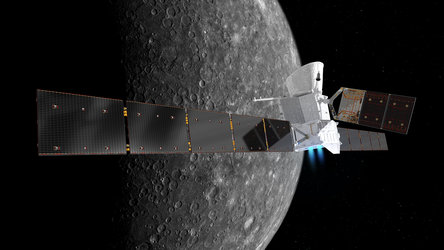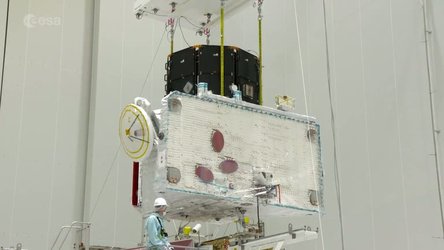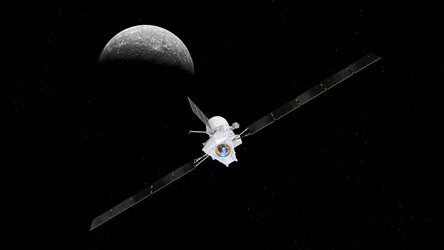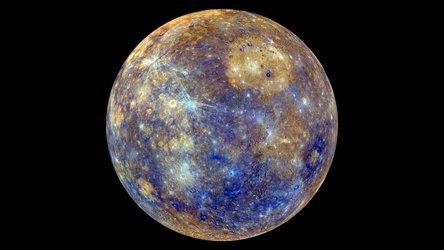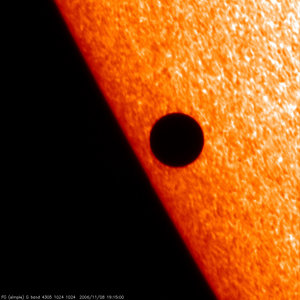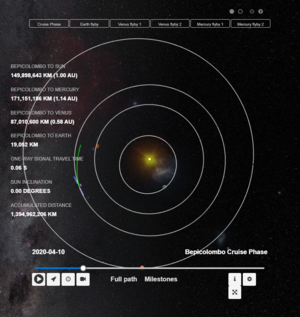BepiColombo takes last snaps of Earth en route to Mercury
The ESA/JAXA BepiColombo mission completed its first flyby on 10 April, as the spacecraft came less than 12 700 km from Earth’s surface at 06:25 CEST, steering its trajectory towards the final destination, Mercury. Images gathered just before closest approach portray our planet shining through darkness, during one of humankind’s most challenging times in recent history.
Launched in 2018, BepiColombo is on a seven-year journey to the smallest and innermost planet orbiting the Sun, which holds important clues about the formation and evolution of the entire Solar System.
Today’s operation is the first of nine flybys which, together with the onboard solar propulsion system, will help the spacecraft reach its target orbit around Mercury. The next two flybys will take place at Venus and further six at Mercury itself

While the manoeuvre took advantage of Earth’s gravity to adjust the path of the spacecraft and did not require any active operations, such as firing thrusters, it included 34 critical minutes shortly after BepiColombo’s closest approach to our planet, when the spacecraft flew across the shadow of Earth.
“This eclipse phase was the most delicate part of the flyby, with the spacecraft passing through the shadow of our planet and not receiving any direct sunlight for the first time after launch,” said Elsa Montagnon, BepiColombo Spacecraft Operations Manager for ESA.

To prepare for the scheduled eclipse, mission operators fully charged the spacecraft batteries and warmed up all components in advance, then closely monitored the temperature of all onboard systems during the period in darkness, between 07:01 and 07:35 CEST.
“It is always nerve-wracking to know a spacecraft’s solar panels are not bathed in sunlight. When we saw the solar cells had restarted to generate electrical current, we knew BepiColombo was finally out of Earth’s shadow and ready to proceed on its interplanetary journey,” added Elsa.
Space operations are never routine at ESA’s mission control centre in Darmstadt, Germany, but today’s flyby had one extra challenge. The manoeuvre, programmed long in advance and impossible to postpone, had to be prepared with limited on-site personnel, amid the social distancing measures adopted by the Agency in response to the ongoing coronavirus pandemic; but the restrictions had no impact on the operation’s success.
As BepiColombo swung by our planet, most scientific instruments on ESA’s Mercury Planetary Orbiter – one of the two science spacecraft that make up the mission – were switched on. Several sensors were also active on the second component of the mission, JAXA’s Mercury Magnetospheric Orbiter, also known as Mio.

Scientists will use the data gathered during the flyby, which include images of the Moon and measurements of Earth’s magnetic field as the spacecraft zipped past, to calibrate the instruments that will, as of 2026, investigate Mercury to solve the mystery of how the scorched planet formed.
“Today was of course very different to what we could have imagined only a couple of months ago,” said Johannes Benkhoff, ESA’s BepiColombo Project Scientist, who followed the operation from his home in the Netherlands, along with the many scientists from the 16 instrument teams that comprise the mission, scattered between Europe and Japan.
“We are all pleased that the flyby went well and that we could operate several scientific instruments, and we are looking forward to receiving and analysing the data. These will also be useful to prepare for the next flyby, when BepiColombo will swing past Venus in October.”
“There is a great interest in Japan in the BepiColombo mission. Thus, after the successful flyby we are looking forward to the science at Venus and Mercury,” said Go Murakami, BepiColombo Project Scientist at JAXA.
Our home from space

On 9 April, ahead of the flyby, and then again today, just before closing in, the BepiColombo monitoring cameras snapped a series of images of Earth from space, picturing our planet in these difficult times for humans across Europe and the world.
“These selfies from space are humbling, showing our planet, the common home that we share, in one of the most troubling and uncertain periods many of us have gone through,” said Günther Hasinger, ESA’s Director of Science, who also followed the event remotely from home, in Spain.
“We are scientists who fly spacecraft to explore the Solar System and observe the Universe in search of our cosmic origins, but before that we are humans, caring for one another and coping with a planetary emergency together. When I look at these images, I am reminded of the strength and resilience of humankind, of the challenges we can overcome when we team up, and I wish they bring you the same sense of hope for our future.”
Join us on ESA Web TV on 10 April at 17:00 CEST for a live streamed conversation featuring ESA mission experts and scientists from some of the instrument teams, reflecting on the flyby and presenting data gathered by the different instruments: https://esawebtv.esa.int
For updates on the science data obtained during the flyby and images to be taken by the BepiColombo monitoring cameras as the spacecraft moves away from Earth on 10 and 11 April, follow the mission on Twitter via: @ESA_Bepi, @ESA_MTM, and @BepiColombo
About BepiColombo
BepiColombo is Europe's first mission to Mercury. Launched on 20 October 2018, it is on a seven-year journey to the smallest and least explored terrestrial planet in our Solar System. The mission is a joint endeavour between ESA and the Japan Aerospace Exploration Agency (JAXA), carried out under ESA leadership.
BepiColombo comprises two scientific orbiters: ESA’s Mercury Planetary Orbiter (MPO) and JAXA’s Mercury Magnetospheric Orbiter (Mio). After arrival at Mercury in late 2025, it will need more than 15 additional manoeuvres to place the two orbiters in their dedicated polar orbits around the planet. Starting science operations in early 2026, both orbiters will gather data during a one-year nominal mission, with a possible one-year extension. The mission is named after the Italian mathematician and engineer Giuseppe (Bepi) Colombo (1920–84).
Follow the mission via https://www.esa.int/BepiColombo/
The JAXA mission website is available in English here: http://mio.isas.jaxa.jp/en/
For further information
ESA Media Relations Office – Ninja Menning
Tel: +31 71 565 6409
Email: media@esa.int



